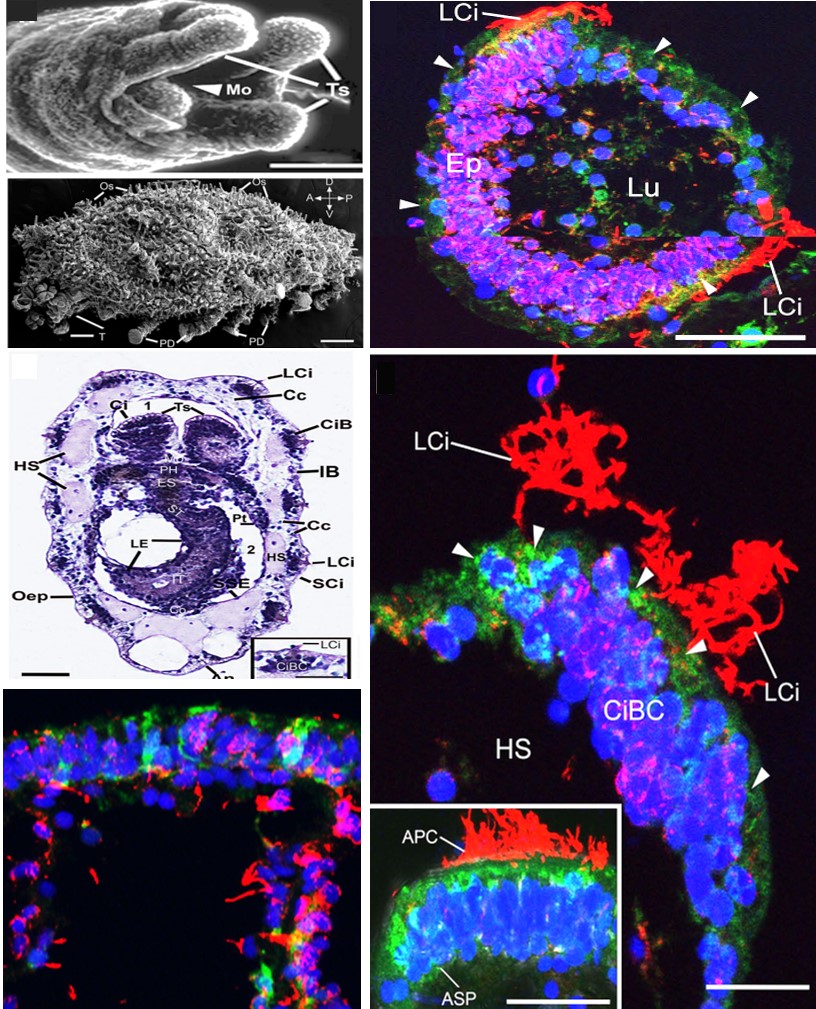
การศึกษาการปรากฎและการกระจายของ GABA และ dopamine ในอวัยวะที่ช่วยในการลงเกาะของลูกปลิงทะเลขาว Holothuria scabra
Highlight:
ในการศึกษาครั้งนี้ คณะผู้วิจัยได้ทำการตรวจสอบการปรากฏและการกระจายของ GABA และ DA ในระยะตัวอ่อนขั้นต่างๆของ H. scabra โดยได้เน้นศึกษาเป็นพิเศษที่อวัยวะที่ช่วยในการลงเกาะ (settlement organs, SOs) ซึ่งพบว่า มีการปรากฏ และการกระจายแบบจำเพาะของเซลล์และเส้นใย GABA และ DA ในโครงสร้าง SO หลายโครงสร้าง รวมถึง ซีเลียรีแบนด์ (ciliary bands, CiBs), เทนทาเคิล (tentacle, Ts) และโพเดีย (PDs) ของตัวอ่อน H. scabra นอกจากนี้ คณะผู้วิจัยยังพบว่า จำนวนเซลล์และความเข้มของ GABA-ir และ DA-ir-positive ใน CiBs, Ts และ PDs ในระหว่างขั้นตอนการพัฒนาของตัวอ่อนในระยะต่างๆนั้น มีการเปลี่ยนแปลงที่จำเพาะไปตามระยะการพัฒนาของตัวอ่อน ในการศึกษานี้ คณะผู้วิจัยเป็นกลุ่มแรกแรกที่ได้ศึกษาเกี่ยวกับการปรากฏ ของระบบ GABAergic และ dopaminergic ในโครงสร้างที่เกี่ยวข้องกับการลงเกาะของปลิงทะเล H. scabra ซึ่งการค้นพบนี้ได้ให้ข้อมูลบ่งชี้ที่สำคัญที่บ่งชี้ถึงบทบาทและกลไกที่สำคัญของสารสื่อประสาททั้งสองนี้ในการควบคุมการลงเกาะของปลิงทะเล H. scabra
ที่มาและความสำคัญ
In the sea cucumber, Holothuria scabra, the competent larvae require main settlement organs (SOs), including the ciliary bands, tentacles, and podia, as well as cues from major neurotransmitters, including gamma-aminobutyric acid (GABA) and dopamine (DA), for successful settlement. However, the presence and differential expression of DA during the developmental stages in H. scabra, have not yet been investigated. Additionally, the exact location for the production and secretion of these two neurotransmitters in the SO needs to be characterized so that this important knowledge may help increase the production of this sea cucumber species. In the present study, we investigated and mapped the presence and distribution of GABA and DA in several organs that may be involved in mediating the settlement of H. scabra larvae, with special emphasis on SOs, during different developmental stages. Our findings shed important light on the anatomical localization and potential implications of the two neurotransmitter systems in SOs to control the larval settlement process in this sea cucumber species.
Abstract
In the sea cucumber, Holothuria scabra, the competent larvae require main settlement organs (SOs), including the ciliary bands (CiBs), tentacles (Ts), podia (PDs), and cues from neurotransmitters, including gamma-aminobutyric acid (GABA) and dopamine (DA), for successful settlement. In the present study, we investigated the spatial distribution of GABA and DA in the developmental stages of H. scabra, with special emphasis on SOs by detecting immunoreactivity (-ir) against these two neurotransmitters. Strong GABA-ir and DA-ir cells and fibers were specifically detected in several SO structures, including CiBs, CiB cells (CiBCs), and long cilia (LCi), of H. scabra larvae. Additionally, we found intense GABA-ir and DA-ir cells in the epithelial lining of bud-papillae (BP) and mesothelium (Me) in the stem (S) region of Ts in larvae and juveniles. Intense GABA-ir and DA-ir were observed in the epineural nerve plexus (ENP) and hyponeural nerve plexus (HNP) of Ts in H. scabra pentactula and juvenile stages. Staining for these two neurotransmitters was particularly intense in the PDs and their nerve fibers. We also found significant changes in the numbers of GABA-ir and DA-ir-positive cells and intensities in the CiBs, Ts, and PDs during the developmental stages. Taken together, we are the first to report on the existence and distribution of GABAergic and dopaminergic systems in structures associated with the settlement. Our findings provide new and important insights into the possible functions of these two neurotransmitters in regulating the settlement of this sea cucumber species.
Keywords: GABA, Dopamine, Settlement organs, Sea cucumber, Holothuria scabra
Citation: Nontunha N, Tinikul R, Chaichotranunt S, Poomtong T, Sobhon P, Tinikul Y. (2023). The presence and distribution of gamma-aminobutyric acid and dopamine during the developmental stages of the sea cucumber, Holothuria scabra, with emphasis on settlement organs. Cell Tissue Res391, 457–483 (2023). https://doi.org/10.1007/s00441-023-03739-9
RELATED SDGs:
14. LIFE BELOW WATER

ผู้ให้ข้อมูล: รองศาสตราจารย์ ดร.ยสวันต์ ตินิกุล
ชื่ออาจารย์ที่ทำวิจัย: รองศาสตราจารย์ ดร.ยสวันต์ ตินิกุล
ชื่อนักศึกษาที่ทำวิจัย: นางสาวนิตติญา นนทันหา
แหล่งทุนวิจัย: Mahidol University (Fundamental Fund: Basic Research Fund, fiscal year 2022), Agricultural Research Development Agency, Thailand Science Research and Innovation and Mahidol University, and Faculty of Science, Mahidol University.
Tags: Dopamine, GABA, Holothuria scabra, Sea cucumber, Settlement organs
